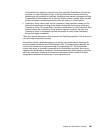
Chapter 23. Global Mirror options and configuration 271
disk subsystem at the local site. If you did not establish these paths in the very first step,
then this is the time to create these paths before you continue with the next step.
5. Define a token that identifies the Global Mirror session. This is a session ID with a number
between 1 and 255. Define this session number to the Master storage disk subsystem and
also to all potentially involved primary LSSs that are going to be part of this Global Mirror
session and will contain Global Copy primary volumes that will belong to the Global Mirror
session. All primary LSSs include all LSSs in potential Subordinate storage disk
subsystems that are going to be part of the Global Mirror session.
6. The next step populates the session with the Global Copy primary volumes. You should
put these Global Copy primary volumes into the session after they complete their first
pass for initial copy.
7. Start the session. This command actually defines the Master LSS. All further session
commands have to go through this LSS. You may specify with the start command the
Global Mirror tuning parameters such as maximum drain time, maximum coordination
time, and Consistency Group interval time.
You go through this recommended sequence independent of the interface used.
23.3 Modify a Global Mirror session
Once a session is active and running, you may alter the Global Mirror environment to add or
remove volumes. You may also add storage disk subsystems to a Global Mirror session or
you may change the interval between the formation of Consistency Groups.
23.3.1 Add or remove volumes to a Global Mirror session
Volumes can be added to the session at any time after the session number is defined to the
LSS where the volumes reside. Once the session is started, volumes can be added to the
session or can be removed from the session also at any time.
Volumes may be added to a session in any state, for example,
simplex or pending. Volumes
that have not completed their initial copy phase stay in a
join pending state until the first initial
copy is complete. If a volume in a session is
suspended, it will cause Consistency Group
formation to fail.
We recommend that you add only Global Copy primary volumes that have completed their
initial copy or first pass, although the microcode itself will stop volumes from joining the
Global Mirror session until the first pass is complete. Also, we recommend that you wait until
the first initial copy is complete before you establish the FlashCopy relationship between the
B and the C volumes.
When you add a rather large number of volumes at once to an existing Global Mirror session,
then the available resources for Global Copy within the affected ranks may be utilized by the
initial copy pass. To minimize the impact to the production servers when adding many new
Note: You only add Global Copy primary volumes to a Global Mirror session.
Note: You cannot add a Metro Mirror primary volume to a Global Mirror session. Global
Mirror supports only Global Copy pairs. When Global Mirror detects a volume which, for
example, is converted from Global Copy to Metro Mirror, the following formation of a
Consistency Group will fail.


















